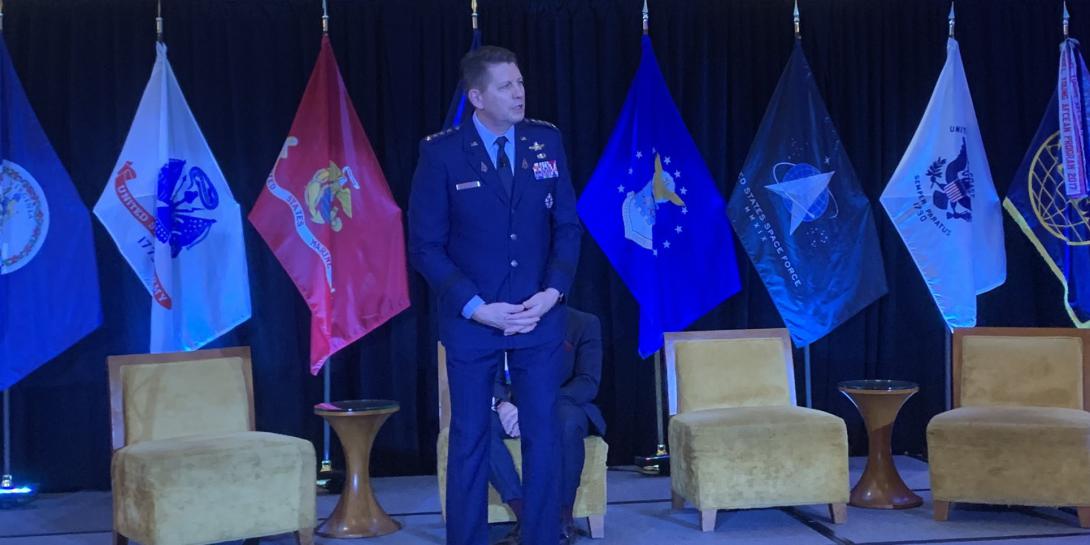The Importance of Digital Pitches
The young U.S. Space Force is determined to be a military service that is based on a digital culture. Leaders are requiring all guardians—including the officers themselves—to have digital aptitude. The service put itself on a path to have a digital headquarters, with a vision of cutting-edge tools, analytics and low bureaucratic burdens. The lofty goal of digital operations centers driving joint all-domain solutions that support the military in, from and to space, is to gain advantage through an interconnected infrastructure, explained Gen. David Thompson, USSF, vice chief, Space Operations, Space Force.
It is the foundation of digital engineering, however, that will underlie the service’s programs and acquisitions, said Gen. Thompson, speaking at AFCEA NOVA’s Space Force Information Technology Day on February 10 in Herndon, Virginia.
“We've already put in place the policy that says every single new space program from here on out will be set on the foundation of digital engineering,” the vice chief said. “We are also determining those programs that are currently in place where we can go back and implement that digital engineering baseline. But from here on out, when we talk about how our programs will go forward, it will be with digital engineering.”
For the defense industrial base supporting the Space Force, this digital engineering foundation means companies must have the ability to present capability and technology options to the service digitally—via computer models, simulation, data and other digital tools to represent the aspects of a complex space system.
Gen. Thompson cited an example from an event last fall with the service’s Space Warfighting Analysis Center. The so-called SWAC, led by Andrew Cox, was created in April of 2021 and hosted a solicitation event in October with industry. The SWAC is focusing on force design concepts, “where we take requirements, capabilities and threats and model them all digitally to help build force design options based on performance, against requirements, and how these things stand up against the threat,” the vice chief explained. “In October, the center had an industry day focused on missile warning and tracking. The center handed out digital models of threats, handed out digital information on performance, survivability and expectations and said, ‘Go take those models, develop your vision and your idea for what the system looks like to meet that need and come back and show us. Bring us back your digital model and data.'”
The service is building off of that example to instill the importance of digital engineering across the industry, the general emphasized.
“That is the [environment] we are trying to invoke on the acquisition side through digital engineering,” Gen. Thompson noted. “Don’t bring that Power Point. Don’t bring us back a glossy brochure. And this [is our] expectation going forward.”
That kind of digital culture would also enable warfighters inside of the service to develop capabilities. “Digital engineering will help guardians rapidly mature innovative concepts into integrated solutions and deliver critical warfighting capabilities,” Gen. Thompson stated.
As part of their digital workforce, the service also is pursuing the development of digital ninjas, or “super coders,” groups of guardians specializing in offensive and defensive cyber that they will be embedded in roles across the service.
In addition, the vice chief reported the move of the Space Development Agency (SDA) from the Office of the Secretary of Defense into the Space Force was on track and would be completed by next October.
“Right now, we are working to incorporate and make them part of the service,” he said. “They are already integrating themselves effectively in force design and we’ve just finished in our preparation to start moving forward with their tracking defense architecture. The work they are doing with the tracking layer fits very nicely into our architecture. We are in the planning process of the physical and administrative aspects of bringing them to make sure that we can bring in their personnel without disrupting their [activities].
“The demand, the expectation and frankly the need [is there] for us to develop into what is truly a 21st century digital service,” the general said.





Comments